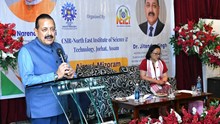
Pearl, often hailed as the "queen of gems," is cherished for its natural beauty and timeless elegance. With its captivating luster and unique origin from the depths of an oyster, it holds a special place among precious jewels. In India, pearls carry deep cultural significance and present immense potential in the global market. However, due to overexploitation and rising pollution in natural pearl reserves, the focus has shifted to cultured pearl farming—a sustainable, eco-friendly alternative that's redefining pearl production and positioning India as a rising leader in the global pearl industry.
A pearl is a biological gem formed within mollusks such as oysters and mussels. Its main component, calcium carbonate, makes up about 85% of its structure, along with 12% organic matrix and a small amount of water. Pearl formation begins when an irritant—often a grain of sand or a parasite—enters the mollusk's body. To protect itself, the mollusk secretes nacre, a lustrous substance that layers around the intruder, gradually forming a pearl.
Natural pearls are increasingly rare. Hence, pearl cultivation or farming, which mimics this natural phenomenon, has become a prominent industry. Cultured pearls, produced with human intervention, share the same composition and beauty as natural ones, but offer consistency in size, shape, and color.
Understanding the Types of Pearls
Pearls are generally classified into three types: Natural, Cultured, and Designed Cultured.
-
Natural pearls are typically smaller in size with a rough, irregular surface. They form organically when a foreign particle—such as a grain of sand or a parasite—becomes lodged inside a shellfish and cannot be expelled. In response, the mollusk secretes layers of nacre around the irritant to reduce discomfort, eventually creating a pearl. Due to their rarity, natural pearls are highly prized and often considered the most valuable.
-
Cultured pearls, by contrast, are produced through a process of surgical implantation. A small bead or piece of shell is carefully inserted into the mollusk to stimulate nacre secretion. This method helps reduce the pressure on natural pearl resources and makes pearls more accessible and affordable, which is why cultured pearls dominate the global market today.
-
A third category, Designed Cultured pearls, involves the deliberate insertion of specific shapes or flat bases into the mollusk. While their formation is guided by human intervention, these pearls still develop layers of natural nacre. Their distinctive shapes and aesthetic appeal make them especially popular in the fashion and jewelry industries.
Pearl Farming: A Step-by-Step Guide
-
Selecting the Right Site and Collecting Mussels
The success of pearl farming largely depends on choosing an appropriate site. Ideal locations are freshwater sources with clean, clear water, free from pollutants and harmful algal blooms such as Microcystis. Mussels, the core species used in pearl cultivation, are generally sourced from natural water bodies like rivers and ponds. Selection is based on their health, size, and weight—typically around 8 cm in length and approximately 35 grams.
-
Pre-Grafting Care
Before surgery, mussels are kept in tanks under specific conditions to relax their adductor muscles, making it easier to open their shells. Unlike marine oysters, the freshwater species used (typically Lamellidens) require no anesthesia.
-
Grafting and Surgical Implantation
The core of pearl farming lies in the implantation process. A graft—a piece of mantle tissue from a donor shell—is combined with a nucleus (bead made from shell powder or acrylic) and inserted into the recipient mussel. There are three main techniques:
-
Shell Cavity Implantation: A simpler method where the nucleus is placed between the shell layers.
-
Mantle Tissue Implantation: Involves embedding the nucleus into the mantle lobes. This method yields better pearl formation rates (60–70%).
-
Gonadal Implantation: A nucleus is implanted into the gonads. It has a lower success rate (25–30%) but can produce designer pearls.

Post-Operative Care
Post-implantation, mussels undergo intensive care. Broad-spectrum antibiotics are administered to prevent infection and rejection. They are fed green algae and kept in well-aerated tanks for 7–10 days to stabilize before transferring to the culture system.
Culture and Growth
Cultured mussels are placed in nylon mesh bags and suspended in ponds or tanks. The culture pond should have a clay bottom and a depth ranging from 1.5 to 2 meters. The water must be slightly alkaline, with a pH between 7.0 and 8.0. Additionally, maintaining dissolved oxygen levels between 4 to 8 ppm and a temperature range of 25–30°C is essential for optimal mussel health and pearl formation. Mussels are typically cultured for 12–18 months.
For farmers without access to ponds, FRP or ferrocement tanks provide a viable alternative. These systems allow for better monitoring, ease of maintenance, and controlled conditions.
Harvesting and Re-implantation
After the culture period, pearls are harvested. Their quality is assessed based on luster, shape, size, and color. If the mantle implantation method was used, mussels can be reused for further cycles. However, in cavity implantation, the mussels are often sacrificed to retrieve the pearl.
Challenges in Indian Pearl Farming
Despite its immense potential, pearl cultivation in India is confronted with several significant challenges. One of the primary issues is the absence of a well-organized industry and standardized cultivation practices, which hampers large-scale and uniform production.
Additionally, there is limited access to high-quality mussel spawners, making it difficult for farmers to maintain consistent yields. The lack of adequate research and poor dissemination of pearl farming technology across the country’s diverse agro-climatic zones further restricts its expansion.
Moreover, inadequate infrastructure and minimal involvement from the private sector pose additional barriers. These combined factors limit the scalability and reliability of pearl production, even as the demand for pearls—both within India and internationally—continues to grow.
Government Support and Future Outlook
Recognizing the potential of pearl farming. Many government institutions have started providing schemes and hands-on training for pearl farming in India. The Department of Fisheries, Ministry of Fisheries, Animal Husbandry & Dairying (MoFAH&D), Government of India, has launched several initiatives to promote pearl farming across the country.
Under the Pradhan Mantri Matsya Sampada Yojana (PMMSY), 2,307 bivalve cultivation units—including pearl farming—have been approved with a total allocation of Rs 461 lakh.
The government has also developed India’s first pearl farming cluster in Hazaribagh, Jharkhand, and supported farmers in showcasing their work at national and international platforms. ICAR institutes have played a vital role, with ICAR-CIFA training over 1,500 farmers in freshwater pearl farming and ICAR-CMFRI training 400 participants in marine pearl cultivation.
Efforts like ranching 1.65 crore marine pearl oyster seeds in Tamil Nadu and issuing SOPs for cluster development aim to streamline the sector and boost India’s presence in the global pearl market.
Pearl cultivation in India stands at the intersection of tradition, science, and sustainable entrepreneurship. With rising demand, technological advancements, and growing governmental support, freshwater pearl farming offers a promising alternative livelihood for rural communities. By overcoming existing challenges and promoting knowledge dissemination, India can position itself as a significant player in the global pearl industry.
















